Strategic Management Report: Tesco's Strategy, Change, and Models
VerifiedAdded on 2023/01/04
|12
|3255
|71
Report
AI Summary
This report provides a comprehensive analysis of Tesco's strategic management practices. It begins with an introduction to strategic management and then delves into a critical assessment of Tesco's strategy determination process, highlighting the use of SWOT and PESTLE analysis. The report evaluates the critical models and tools organizations use to determine their strategy, specifically focusing on SWOT and PESTLE, and applies these tools to Tesco, examining its strengths, weaknesses, opportunities, and threats. Furthermore, the report critically appraises the importance of change management, considering the complexity of the transformation process, its associated costs, risks, and the need for sustainability. The report concludes with a summary of the key findings and references relevant academic sources. The report also discusses the PESTLE analysis of Tesco considering the political, economic, social, technological, legal, and environmental factors affecting the company. The importance of change management is then critically appraised based on the complexity of the transformation process, its costs, risks, and sustainability. Finally, the report concludes by summarizing the key findings and referencing relevant academic sources.
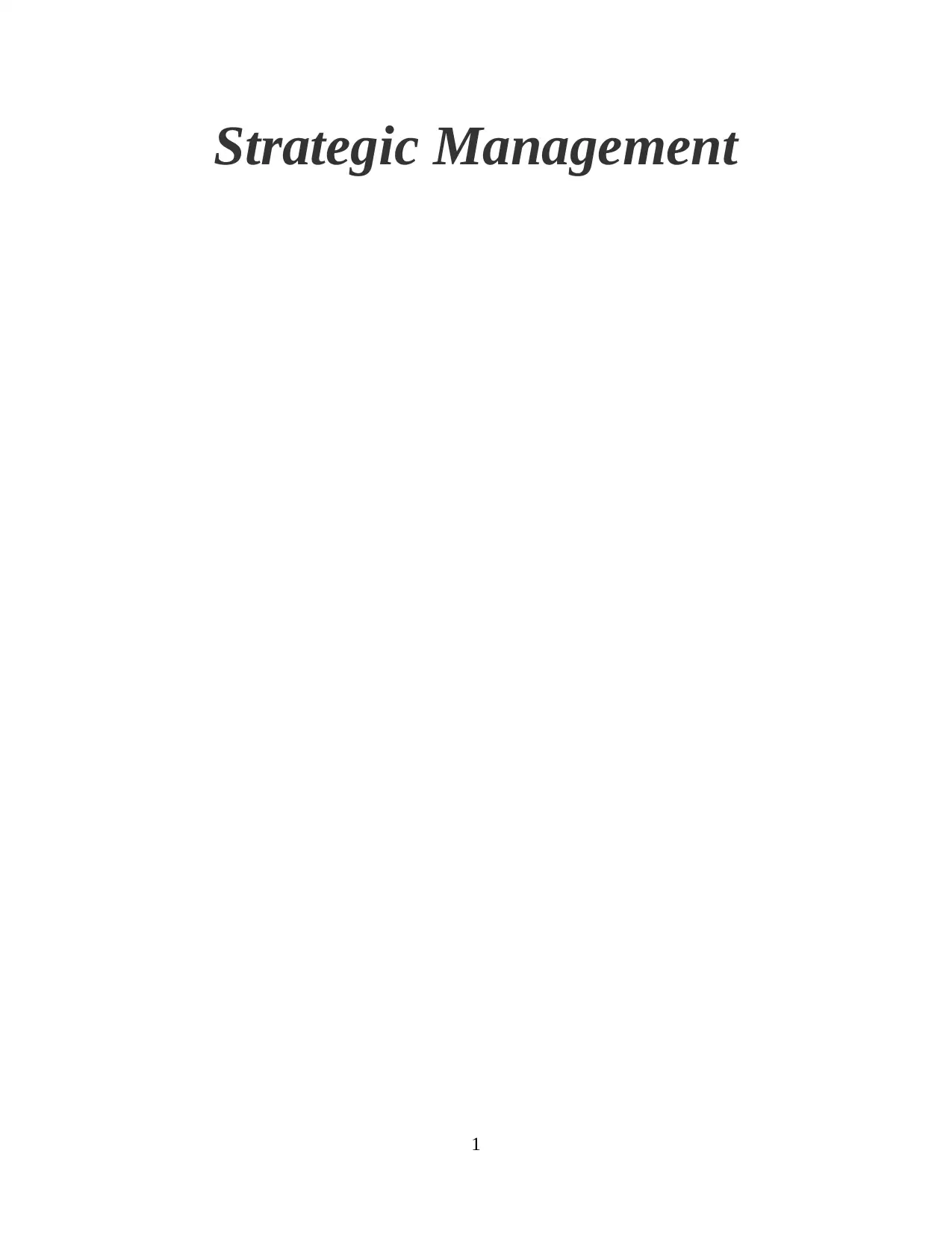
Strategic Management
1
1
Paraphrase This Document
Need a fresh take? Get an instant paraphrase of this document with our AI Paraphraser
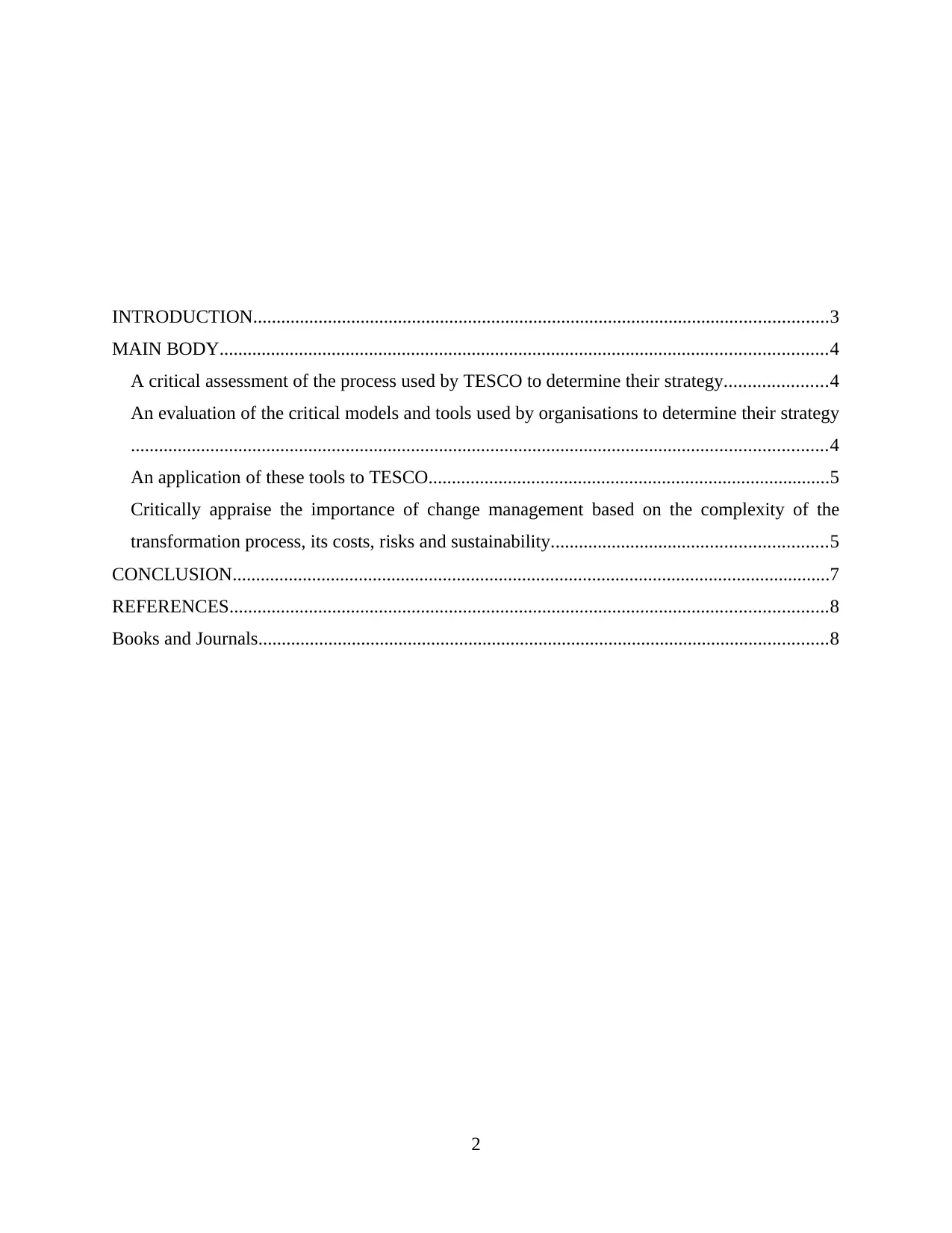
INTRODUCTION...........................................................................................................................3
MAIN BODY..................................................................................................................................4
A critical assessment of the process used by TESCO to determine their strategy......................4
An evaluation of the critical models and tools used by organisations to determine their strategy
.....................................................................................................................................................4
An application of these tools to TESCO......................................................................................5
Critically appraise the importance of change management based on the complexity of the
transformation process, its costs, risks and sustainability...........................................................5
CONCLUSION................................................................................................................................7
REFERENCES................................................................................................................................8
Books and Journals..........................................................................................................................8
2
MAIN BODY..................................................................................................................................4
A critical assessment of the process used by TESCO to determine their strategy......................4
An evaluation of the critical models and tools used by organisations to determine their strategy
.....................................................................................................................................................4
An application of these tools to TESCO......................................................................................5
Critically appraise the importance of change management based on the complexity of the
transformation process, its costs, risks and sustainability...........................................................5
CONCLUSION................................................................................................................................7
REFERENCES................................................................................................................................8
Books and Journals..........................................................................................................................8
2
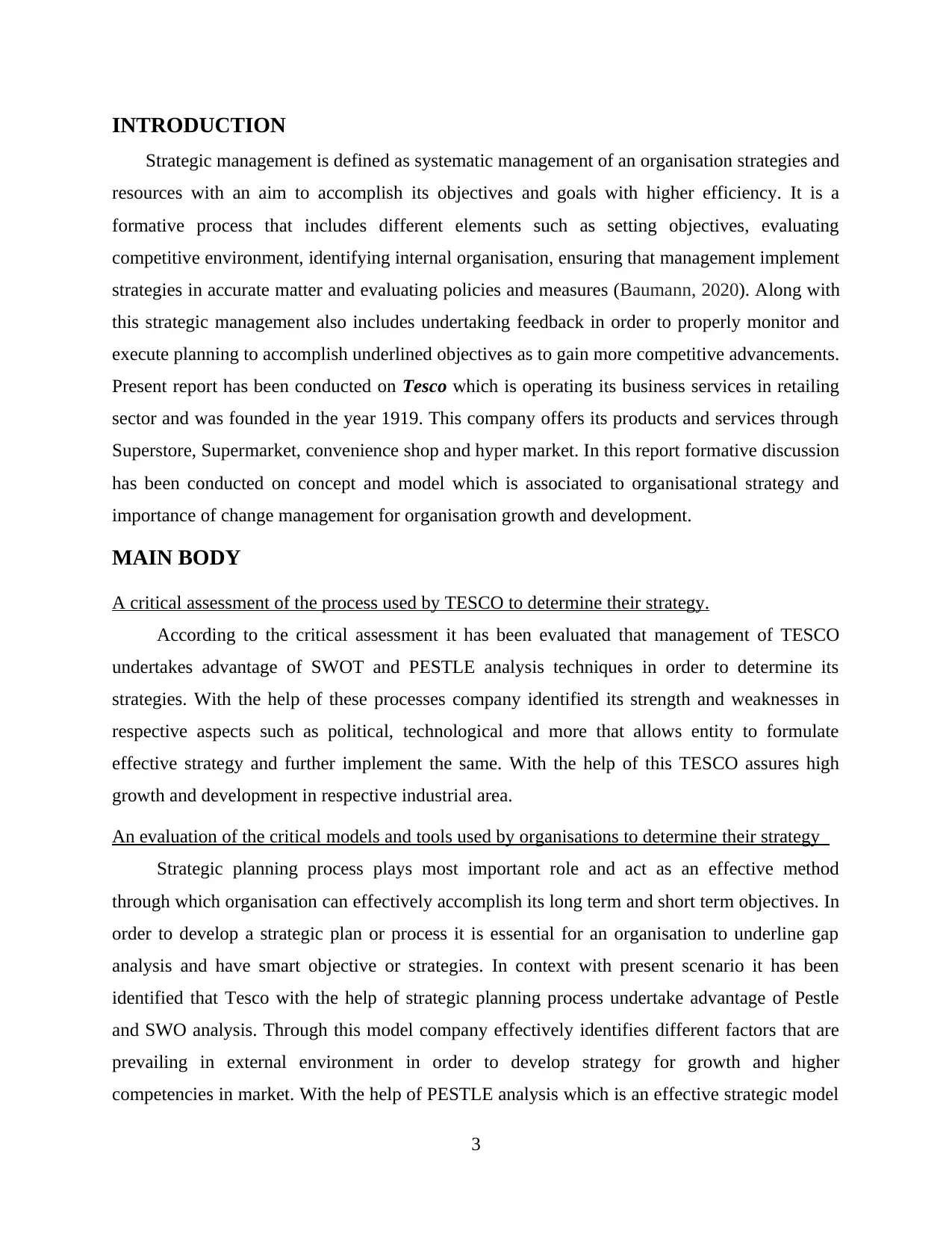
INTRODUCTION
Strategic management is defined as systematic management of an organisation strategies and
resources with an aim to accomplish its objectives and goals with higher efficiency. It is a
formative process that includes different elements such as setting objectives, evaluating
competitive environment, identifying internal organisation, ensuring that management implement
strategies in accurate matter and evaluating policies and measures (Baumann, 2020). Along with
this strategic management also includes undertaking feedback in order to properly monitor and
execute planning to accomplish underlined objectives as to gain more competitive advancements.
Present report has been conducted on Tesco which is operating its business services in retailing
sector and was founded in the year 1919. This company offers its products and services through
Superstore, Supermarket, convenience shop and hyper market. In this report formative discussion
has been conducted on concept and model which is associated to organisational strategy and
importance of change management for organisation growth and development.
MAIN BODY
A critical assessment of the process used by TESCO to determine their strategy.
According to the critical assessment it has been evaluated that management of TESCO
undertakes advantage of SWOT and PESTLE analysis techniques in order to determine its
strategies. With the help of these processes company identified its strength and weaknesses in
respective aspects such as political, technological and more that allows entity to formulate
effective strategy and further implement the same. With the help of this TESCO assures high
growth and development in respective industrial area.
An evaluation of the critical models and tools used by organisations to determine their strategy
Strategic planning process plays most important role and act as an effective method
through which organisation can effectively accomplish its long term and short term objectives. In
order to develop a strategic plan or process it is essential for an organisation to underline gap
analysis and have smart objective or strategies. In context with present scenario it has been
identified that Tesco with the help of strategic planning process undertake advantage of Pestle
and SWO analysis. Through this model company effectively identifies different factors that are
prevailing in external environment in order to develop strategy for growth and higher
competencies in market. With the help of PESTLE analysis which is an effective strategic model
3
Strategic management is defined as systematic management of an organisation strategies and
resources with an aim to accomplish its objectives and goals with higher efficiency. It is a
formative process that includes different elements such as setting objectives, evaluating
competitive environment, identifying internal organisation, ensuring that management implement
strategies in accurate matter and evaluating policies and measures (Baumann, 2020). Along with
this strategic management also includes undertaking feedback in order to properly monitor and
execute planning to accomplish underlined objectives as to gain more competitive advancements.
Present report has been conducted on Tesco which is operating its business services in retailing
sector and was founded in the year 1919. This company offers its products and services through
Superstore, Supermarket, convenience shop and hyper market. In this report formative discussion
has been conducted on concept and model which is associated to organisational strategy and
importance of change management for organisation growth and development.
MAIN BODY
A critical assessment of the process used by TESCO to determine their strategy.
According to the critical assessment it has been evaluated that management of TESCO
undertakes advantage of SWOT and PESTLE analysis techniques in order to determine its
strategies. With the help of these processes company identified its strength and weaknesses in
respective aspects such as political, technological and more that allows entity to formulate
effective strategy and further implement the same. With the help of this TESCO assures high
growth and development in respective industrial area.
An evaluation of the critical models and tools used by organisations to determine their strategy
Strategic planning process plays most important role and act as an effective method
through which organisation can effectively accomplish its long term and short term objectives. In
order to develop a strategic plan or process it is essential for an organisation to underline gap
analysis and have smart objective or strategies. In context with present scenario it has been
identified that Tesco with the help of strategic planning process undertake advantage of Pestle
and SWO analysis. Through this model company effectively identifies different factors that are
prevailing in external environment in order to develop strategy for growth and higher
competencies in market. With the help of PESTLE analysis which is an effective strategic model
3
⊘ This is a preview!⊘
Do you want full access?
Subscribe today to unlock all pages.

Trusted by 1+ million students worldwide
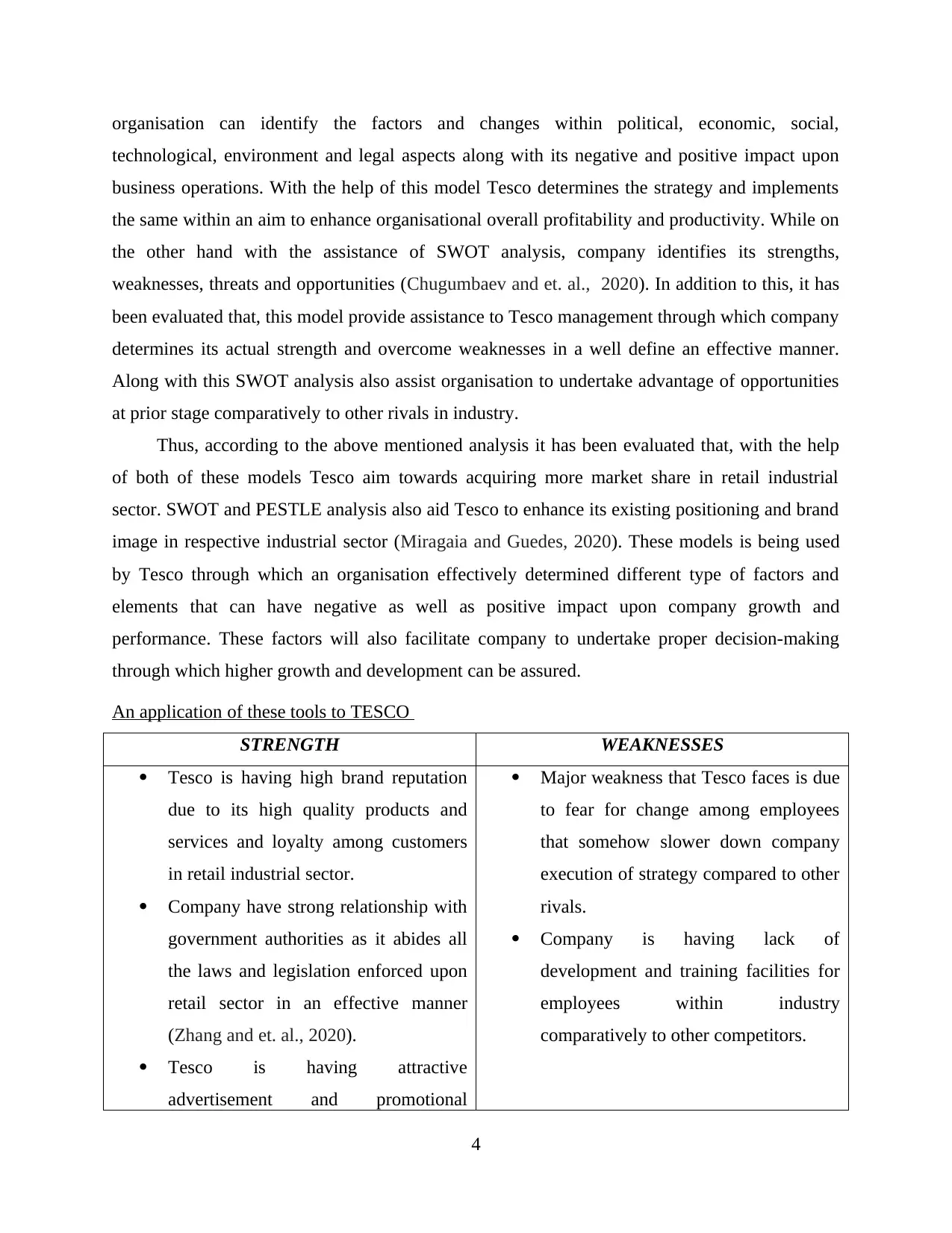
organisation can identify the factors and changes within political, economic, social,
technological, environment and legal aspects along with its negative and positive impact upon
business operations. With the help of this model Tesco determines the strategy and implements
the same within an aim to enhance organisational overall profitability and productivity. While on
the other hand with the assistance of SWOT analysis, company identifies its strengths,
weaknesses, threats and opportunities (Chugumbaev and et. al., 2020). In addition to this, it has
been evaluated that, this model provide assistance to Tesco management through which company
determines its actual strength and overcome weaknesses in a well define an effective manner.
Along with this SWOT analysis also assist organisation to undertake advantage of opportunities
at prior stage comparatively to other rivals in industry.
Thus, according to the above mentioned analysis it has been evaluated that, with the help
of both of these models Tesco aim towards acquiring more market share in retail industrial
sector. SWOT and PESTLE analysis also aid Tesco to enhance its existing positioning and brand
image in respective industrial sector (Miragaia and Guedes, 2020). These models is being used
by Tesco through which an organisation effectively determined different type of factors and
elements that can have negative as well as positive impact upon company growth and
performance. These factors will also facilitate company to undertake proper decision-making
through which higher growth and development can be assured.
An application of these tools to TESCO
STRENGTH WEAKNESSES
Tesco is having high brand reputation
due to its high quality products and
services and loyalty among customers
in retail industrial sector.
Company have strong relationship with
government authorities as it abides all
the laws and legislation enforced upon
retail sector in an effective manner
(Zhang and et. al., 2020).
Tesco is having attractive
advertisement and promotional
Major weakness that Tesco faces is due
to fear for change among employees
that somehow slower down company
execution of strategy compared to other
rivals.
Company is having lack of
development and training facilities for
employees within industry
comparatively to other competitors.
4
technological, environment and legal aspects along with its negative and positive impact upon
business operations. With the help of this model Tesco determines the strategy and implements
the same within an aim to enhance organisational overall profitability and productivity. While on
the other hand with the assistance of SWOT analysis, company identifies its strengths,
weaknesses, threats and opportunities (Chugumbaev and et. al., 2020). In addition to this, it has
been evaluated that, this model provide assistance to Tesco management through which company
determines its actual strength and overcome weaknesses in a well define an effective manner.
Along with this SWOT analysis also assist organisation to undertake advantage of opportunities
at prior stage comparatively to other rivals in industry.
Thus, according to the above mentioned analysis it has been evaluated that, with the help
of both of these models Tesco aim towards acquiring more market share in retail industrial
sector. SWOT and PESTLE analysis also aid Tesco to enhance its existing positioning and brand
image in respective industrial sector (Miragaia and Guedes, 2020). These models is being used
by Tesco through which an organisation effectively determined different type of factors and
elements that can have negative as well as positive impact upon company growth and
performance. These factors will also facilitate company to undertake proper decision-making
through which higher growth and development can be assured.
An application of these tools to TESCO
STRENGTH WEAKNESSES
Tesco is having high brand reputation
due to its high quality products and
services and loyalty among customers
in retail industrial sector.
Company have strong relationship with
government authorities as it abides all
the laws and legislation enforced upon
retail sector in an effective manner
(Zhang and et. al., 2020).
Tesco is having attractive
advertisement and promotional
Major weakness that Tesco faces is due
to fear for change among employees
that somehow slower down company
execution of strategy compared to other
rivals.
Company is having lack of
development and training facilities for
employees within industry
comparatively to other competitors.
4
Paraphrase This Document
Need a fresh take? Get an instant paraphrase of this document with our AI Paraphraser
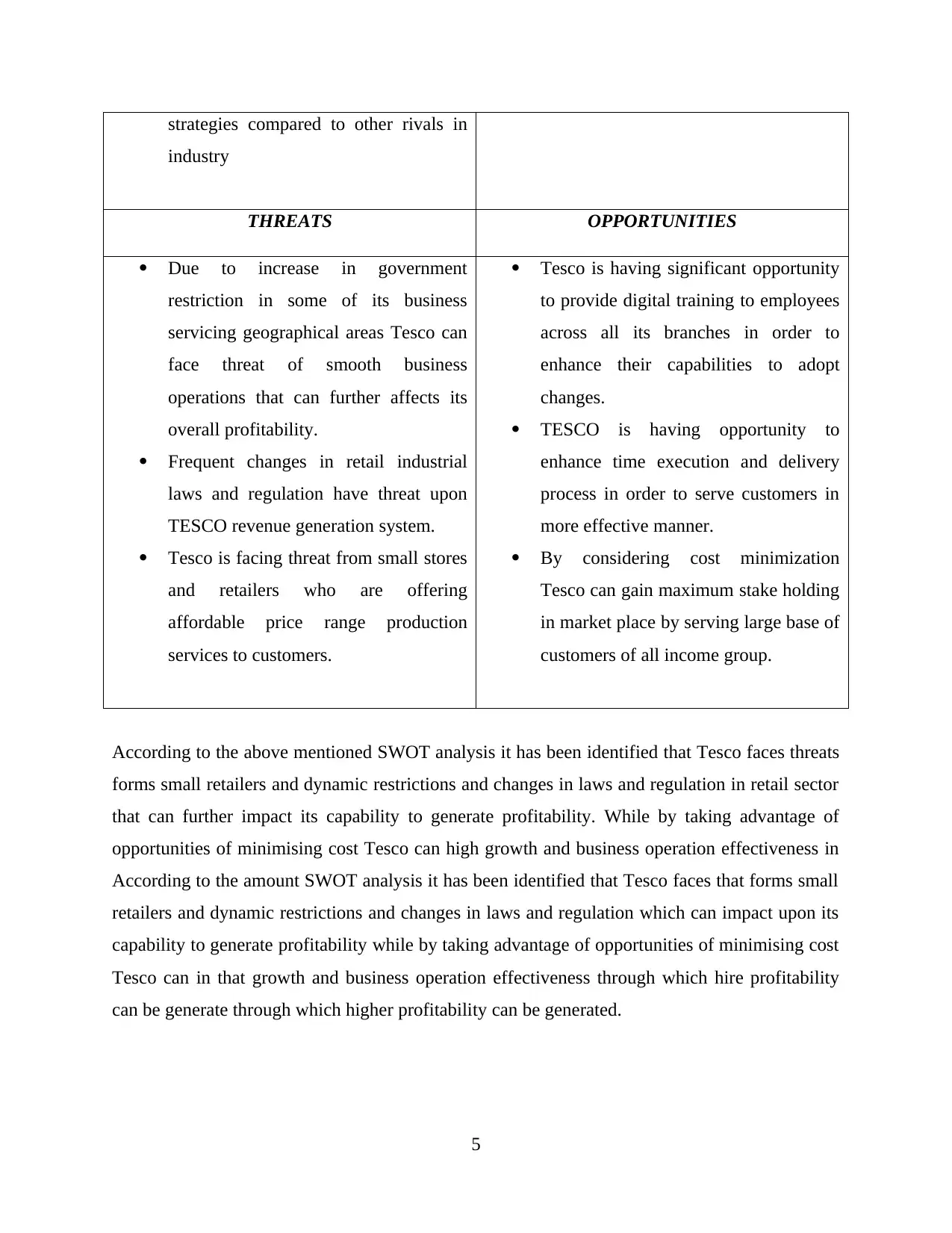
strategies compared to other rivals in
industry
THREATS OPPORTUNITIES
Due to increase in government
restriction in some of its business
servicing geographical areas Tesco can
face threat of smooth business
operations that can further affects its
overall profitability.
Frequent changes in retail industrial
laws and regulation have threat upon
TESCO revenue generation system.
Tesco is facing threat from small stores
and retailers who are offering
affordable price range production
services to customers.
Tesco is having significant opportunity
to provide digital training to employees
across all its branches in order to
enhance their capabilities to adopt
changes.
TESCO is having opportunity to
enhance time execution and delivery
process in order to serve customers in
more effective manner.
By considering cost minimization
Tesco can gain maximum stake holding
in market place by serving large base of
customers of all income group.
According to the above mentioned SWOT analysis it has been identified that Tesco faces threats
forms small retailers and dynamic restrictions and changes in laws and regulation in retail sector
that can further impact its capability to generate profitability. While by taking advantage of
opportunities of minimising cost Tesco can high growth and business operation effectiveness in
According to the amount SWOT analysis it has been identified that Tesco faces that forms small
retailers and dynamic restrictions and changes in laws and regulation which can impact upon its
capability to generate profitability while by taking advantage of opportunities of minimising cost
Tesco can in that growth and business operation effectiveness through which hire profitability
can be generate through which higher profitability can be generated.
5
industry
THREATS OPPORTUNITIES
Due to increase in government
restriction in some of its business
servicing geographical areas Tesco can
face threat of smooth business
operations that can further affects its
overall profitability.
Frequent changes in retail industrial
laws and regulation have threat upon
TESCO revenue generation system.
Tesco is facing threat from small stores
and retailers who are offering
affordable price range production
services to customers.
Tesco is having significant opportunity
to provide digital training to employees
across all its branches in order to
enhance their capabilities to adopt
changes.
TESCO is having opportunity to
enhance time execution and delivery
process in order to serve customers in
more effective manner.
By considering cost minimization
Tesco can gain maximum stake holding
in market place by serving large base of
customers of all income group.
According to the above mentioned SWOT analysis it has been identified that Tesco faces threats
forms small retailers and dynamic restrictions and changes in laws and regulation in retail sector
that can further impact its capability to generate profitability. While by taking advantage of
opportunities of minimising cost Tesco can high growth and business operation effectiveness in
According to the amount SWOT analysis it has been identified that Tesco faces that forms small
retailers and dynamic restrictions and changes in laws and regulation which can impact upon its
capability to generate profitability while by taking advantage of opportunities of minimising cost
Tesco can in that growth and business operation effectiveness through which hire profitability
can be generate through which higher profitability can be generated.
5
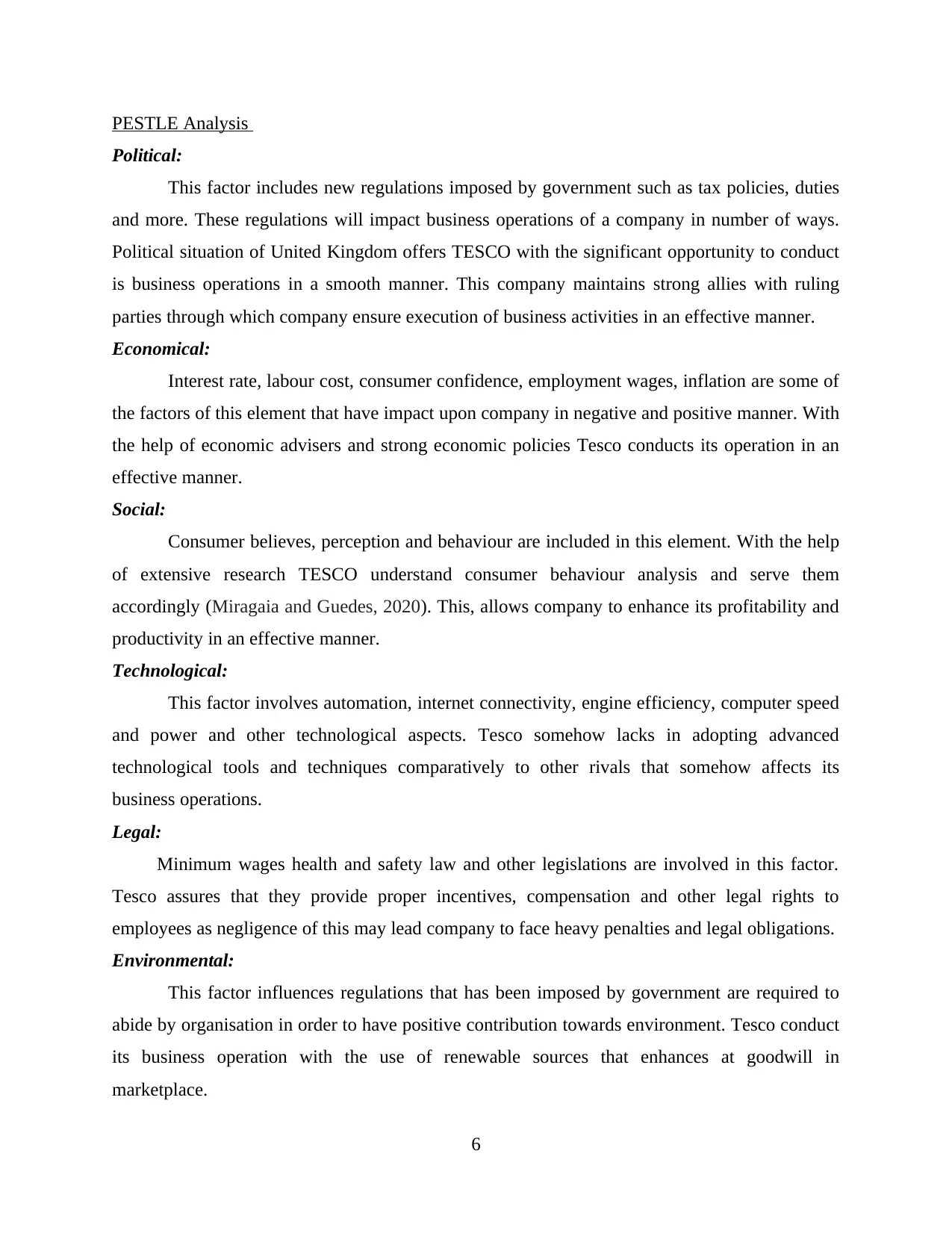
PESTLE Analysis
Political:
This factor includes new regulations imposed by government such as tax policies, duties
and more. These regulations will impact business operations of a company in number of ways.
Political situation of United Kingdom offers TESCO with the significant opportunity to conduct
is business operations in a smooth manner. This company maintains strong allies with ruling
parties through which company ensure execution of business activities in an effective manner.
Economical:
Interest rate, labour cost, consumer confidence, employment wages, inflation are some of
the factors of this element that have impact upon company in negative and positive manner. With
the help of economic advisers and strong economic policies Tesco conducts its operation in an
effective manner.
Social:
Consumer believes, perception and behaviour are included in this element. With the help
of extensive research TESCO understand consumer behaviour analysis and serve them
accordingly (Miragaia and Guedes, 2020). This, allows company to enhance its profitability and
productivity in an effective manner.
Technological:
This factor involves automation, internet connectivity, engine efficiency, computer speed
and power and other technological aspects. Tesco somehow lacks in adopting advanced
technological tools and techniques comparatively to other rivals that somehow affects its
business operations.
Legal:
Minimum wages health and safety law and other legislations are involved in this factor.
Tesco assures that they provide proper incentives, compensation and other legal rights to
employees as negligence of this may lead company to face heavy penalties and legal obligations.
Environmental:
This factor influences regulations that has been imposed by government are required to
abide by organisation in order to have positive contribution towards environment. Tesco conduct
its business operation with the use of renewable sources that enhances at goodwill in
marketplace.
6
Political:
This factor includes new regulations imposed by government such as tax policies, duties
and more. These regulations will impact business operations of a company in number of ways.
Political situation of United Kingdom offers TESCO with the significant opportunity to conduct
is business operations in a smooth manner. This company maintains strong allies with ruling
parties through which company ensure execution of business activities in an effective manner.
Economical:
Interest rate, labour cost, consumer confidence, employment wages, inflation are some of
the factors of this element that have impact upon company in negative and positive manner. With
the help of economic advisers and strong economic policies Tesco conducts its operation in an
effective manner.
Social:
Consumer believes, perception and behaviour are included in this element. With the help
of extensive research TESCO understand consumer behaviour analysis and serve them
accordingly (Miragaia and Guedes, 2020). This, allows company to enhance its profitability and
productivity in an effective manner.
Technological:
This factor involves automation, internet connectivity, engine efficiency, computer speed
and power and other technological aspects. Tesco somehow lacks in adopting advanced
technological tools and techniques comparatively to other rivals that somehow affects its
business operations.
Legal:
Minimum wages health and safety law and other legislations are involved in this factor.
Tesco assures that they provide proper incentives, compensation and other legal rights to
employees as negligence of this may lead company to face heavy penalties and legal obligations.
Environmental:
This factor influences regulations that has been imposed by government are required to
abide by organisation in order to have positive contribution towards environment. Tesco conduct
its business operation with the use of renewable sources that enhances at goodwill in
marketplace.
6
⊘ This is a preview!⊘
Do you want full access?
Subscribe today to unlock all pages.

Trusted by 1+ million students worldwide
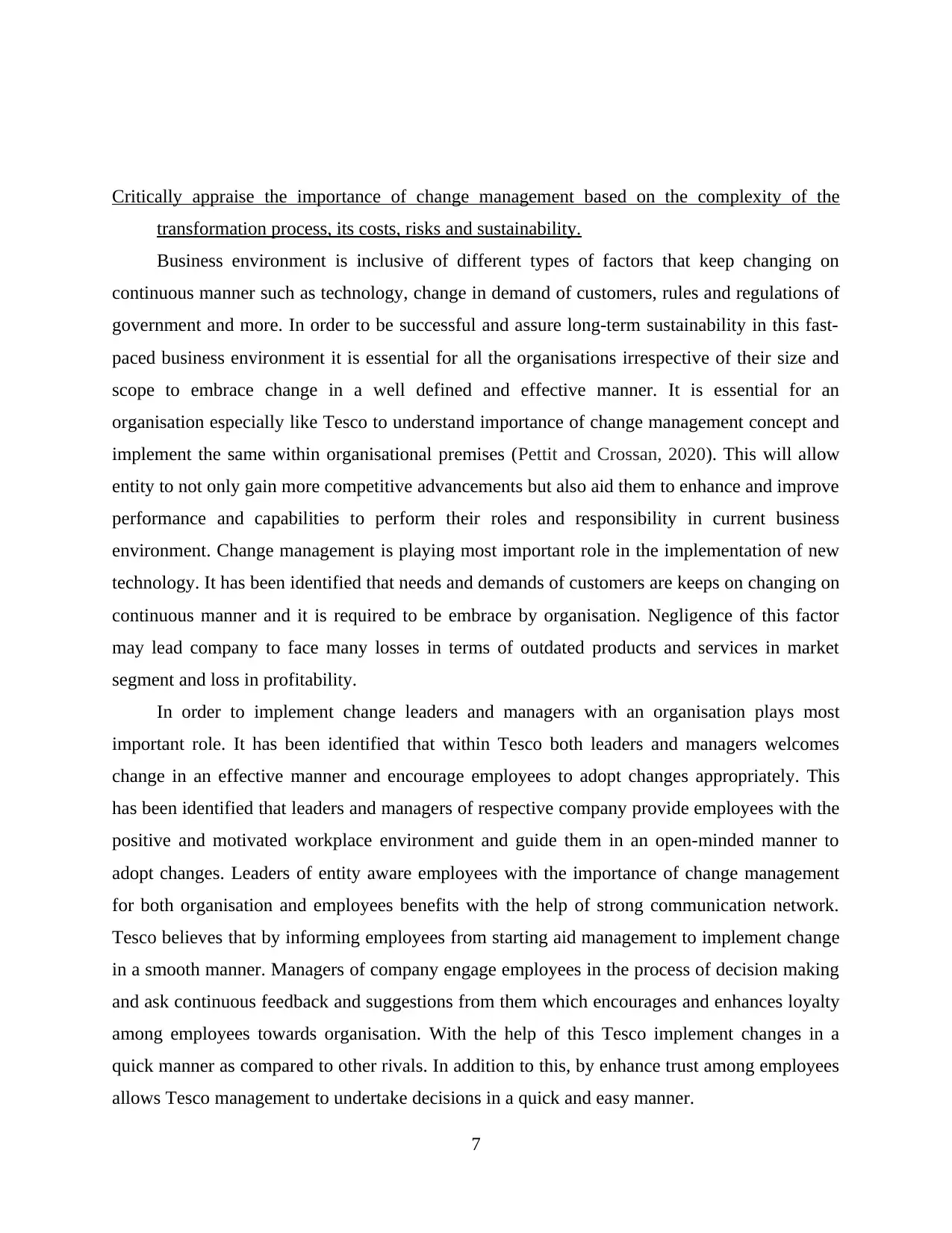
Critically appraise the importance of change management based on the complexity of the
transformation process, its costs, risks and sustainability.
Business environment is inclusive of different types of factors that keep changing on
continuous manner such as technology, change in demand of customers, rules and regulations of
government and more. In order to be successful and assure long-term sustainability in this fast-
paced business environment it is essential for all the organisations irrespective of their size and
scope to embrace change in a well defined and effective manner. It is essential for an
organisation especially like Tesco to understand importance of change management concept and
implement the same within organisational premises (Pettit and Crossan, 2020). This will allow
entity to not only gain more competitive advancements but also aid them to enhance and improve
performance and capabilities to perform their roles and responsibility in current business
environment. Change management is playing most important role in the implementation of new
technology. It has been identified that needs and demands of customers are keeps on changing on
continuous manner and it is required to be embrace by organisation. Negligence of this factor
may lead company to face many losses in terms of outdated products and services in market
segment and loss in profitability.
In order to implement change leaders and managers with an organisation plays most
important role. It has been identified that within Tesco both leaders and managers welcomes
change in an effective manner and encourage employees to adopt changes appropriately. This
has been identified that leaders and managers of respective company provide employees with the
positive and motivated workplace environment and guide them in an open-minded manner to
adopt changes. Leaders of entity aware employees with the importance of change management
for both organisation and employees benefits with the help of strong communication network.
Tesco believes that by informing employees from starting aid management to implement change
in a smooth manner. Managers of company engage employees in the process of decision making
and ask continuous feedback and suggestions from them which encourages and enhances loyalty
among employees towards organisation. With the help of this Tesco implement changes in a
quick manner as compared to other rivals. In addition to this, by enhance trust among employees
allows Tesco management to undertake decisions in a quick and easy manner.
7
transformation process, its costs, risks and sustainability.
Business environment is inclusive of different types of factors that keep changing on
continuous manner such as technology, change in demand of customers, rules and regulations of
government and more. In order to be successful and assure long-term sustainability in this fast-
paced business environment it is essential for all the organisations irrespective of their size and
scope to embrace change in a well defined and effective manner. It is essential for an
organisation especially like Tesco to understand importance of change management concept and
implement the same within organisational premises (Pettit and Crossan, 2020). This will allow
entity to not only gain more competitive advancements but also aid them to enhance and improve
performance and capabilities to perform their roles and responsibility in current business
environment. Change management is playing most important role in the implementation of new
technology. It has been identified that needs and demands of customers are keeps on changing on
continuous manner and it is required to be embrace by organisation. Negligence of this factor
may lead company to face many losses in terms of outdated products and services in market
segment and loss in profitability.
In order to implement change leaders and managers with an organisation plays most
important role. It has been identified that within Tesco both leaders and managers welcomes
change in an effective manner and encourage employees to adopt changes appropriately. This
has been identified that leaders and managers of respective company provide employees with the
positive and motivated workplace environment and guide them in an open-minded manner to
adopt changes. Leaders of entity aware employees with the importance of change management
for both organisation and employees benefits with the help of strong communication network.
Tesco believes that by informing employees from starting aid management to implement change
in a smooth manner. Managers of company engage employees in the process of decision making
and ask continuous feedback and suggestions from them which encourages and enhances loyalty
among employees towards organisation. With the help of this Tesco implement changes in a
quick manner as compared to other rivals. In addition to this, by enhance trust among employees
allows Tesco management to undertake decisions in a quick and easy manner.
7
Paraphrase This Document
Need a fresh take? Get an instant paraphrase of this document with our AI Paraphraser
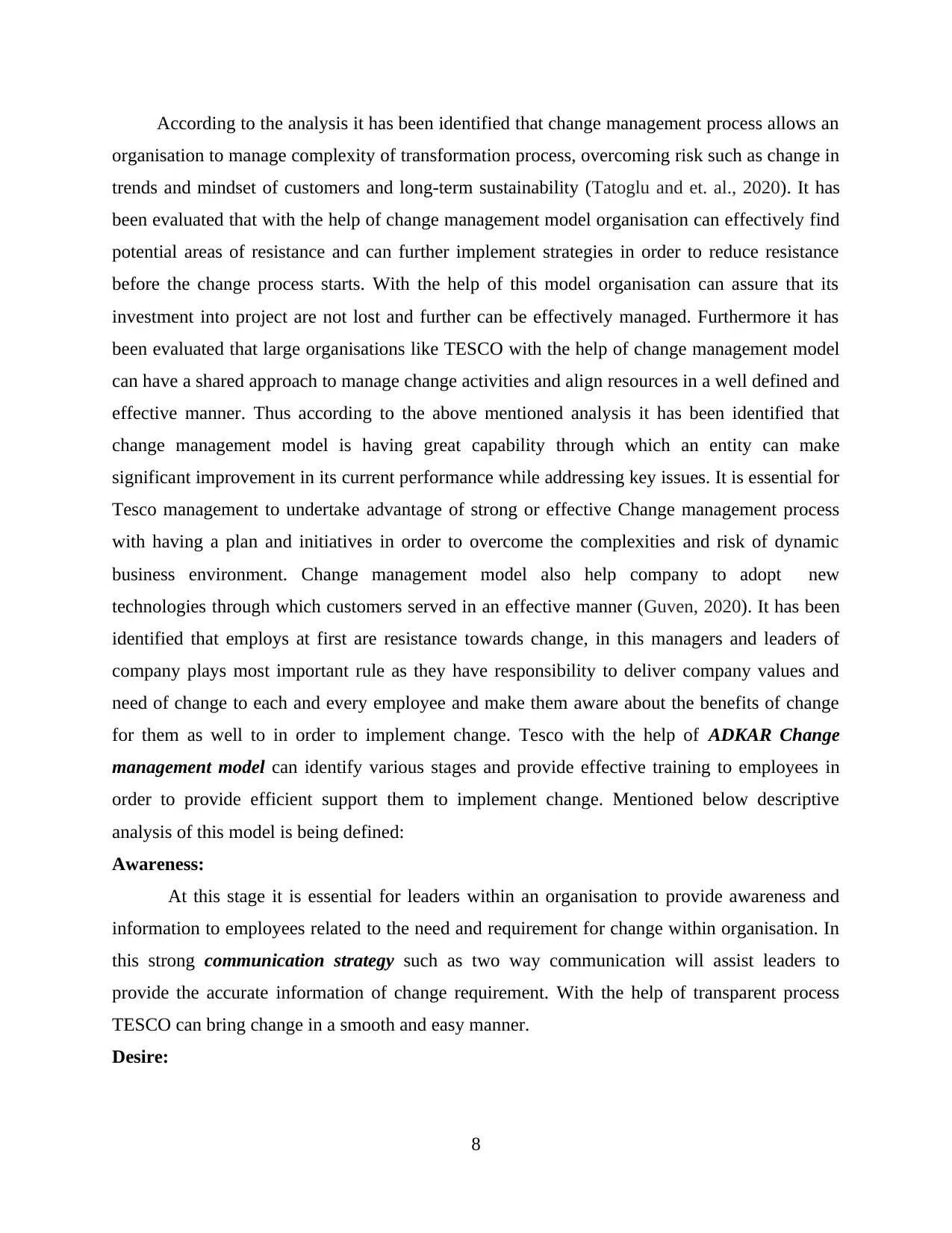
According to the analysis it has been identified that change management process allows an
organisation to manage complexity of transformation process, overcoming risk such as change in
trends and mindset of customers and long-term sustainability (Tatoglu and et. al., 2020). It has
been evaluated that with the help of change management model organisation can effectively find
potential areas of resistance and can further implement strategies in order to reduce resistance
before the change process starts. With the help of this model organisation can assure that its
investment into project are not lost and further can be effectively managed. Furthermore it has
been evaluated that large organisations like TESCO with the help of change management model
can have a shared approach to manage change activities and align resources in a well defined and
effective manner. Thus according to the above mentioned analysis it has been identified that
change management model is having great capability through which an entity can make
significant improvement in its current performance while addressing key issues. It is essential for
Tesco management to undertake advantage of strong or effective Change management process
with having a plan and initiatives in order to overcome the complexities and risk of dynamic
business environment. Change management model also help company to adopt new
technologies through which customers served in an effective manner (Guven, 2020). It has been
identified that employs at first are resistance towards change, in this managers and leaders of
company plays most important rule as they have responsibility to deliver company values and
need of change to each and every employee and make them aware about the benefits of change
for them as well to in order to implement change. Tesco with the help of ADKAR Change
management model can identify various stages and provide effective training to employees in
order to provide efficient support them to implement change. Mentioned below descriptive
analysis of this model is being defined:
Awareness:
At this stage it is essential for leaders within an organisation to provide awareness and
information to employees related to the need and requirement for change within organisation. In
this strong communication strategy such as two way communication will assist leaders to
provide the accurate information of change requirement. With the help of transparent process
TESCO can bring change in a smooth and easy manner.
Desire:
8
organisation to manage complexity of transformation process, overcoming risk such as change in
trends and mindset of customers and long-term sustainability (Tatoglu and et. al., 2020). It has
been evaluated that with the help of change management model organisation can effectively find
potential areas of resistance and can further implement strategies in order to reduce resistance
before the change process starts. With the help of this model organisation can assure that its
investment into project are not lost and further can be effectively managed. Furthermore it has
been evaluated that large organisations like TESCO with the help of change management model
can have a shared approach to manage change activities and align resources in a well defined and
effective manner. Thus according to the above mentioned analysis it has been identified that
change management model is having great capability through which an entity can make
significant improvement in its current performance while addressing key issues. It is essential for
Tesco management to undertake advantage of strong or effective Change management process
with having a plan and initiatives in order to overcome the complexities and risk of dynamic
business environment. Change management model also help company to adopt new
technologies through which customers served in an effective manner (Guven, 2020). It has been
identified that employs at first are resistance towards change, in this managers and leaders of
company plays most important rule as they have responsibility to deliver company values and
need of change to each and every employee and make them aware about the benefits of change
for them as well to in order to implement change. Tesco with the help of ADKAR Change
management model can identify various stages and provide effective training to employees in
order to provide efficient support them to implement change. Mentioned below descriptive
analysis of this model is being defined:
Awareness:
At this stage it is essential for leaders within an organisation to provide awareness and
information to employees related to the need and requirement for change within organisation. In
this strong communication strategy such as two way communication will assist leaders to
provide the accurate information of change requirement. With the help of transparent process
TESCO can bring change in a smooth and easy manner.
Desire:
8
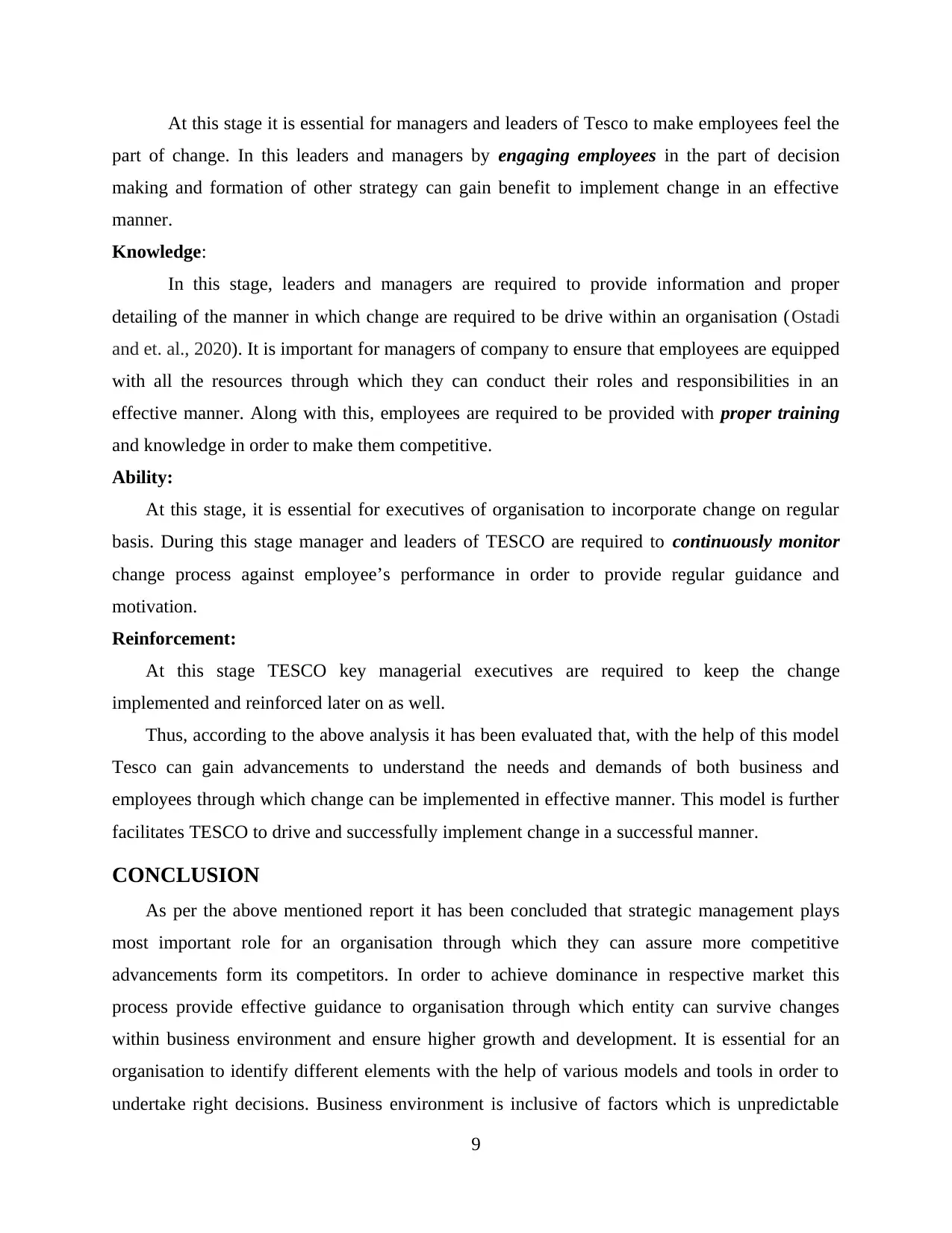
At this stage it is essential for managers and leaders of Tesco to make employees feel the
part of change. In this leaders and managers by engaging employees in the part of decision
making and formation of other strategy can gain benefit to implement change in an effective
manner.
Knowledge:
In this stage, leaders and managers are required to provide information and proper
detailing of the manner in which change are required to be drive within an organisation (Ostadi
and et. al., 2020). It is important for managers of company to ensure that employees are equipped
with all the resources through which they can conduct their roles and responsibilities in an
effective manner. Along with this, employees are required to be provided with proper training
and knowledge in order to make them competitive.
Ability:
At this stage, it is essential for executives of organisation to incorporate change on regular
basis. During this stage manager and leaders of TESCO are required to continuously monitor
change process against employee’s performance in order to provide regular guidance and
motivation.
Reinforcement:
At this stage TESCO key managerial executives are required to keep the change
implemented and reinforced later on as well.
Thus, according to the above analysis it has been evaluated that, with the help of this model
Tesco can gain advancements to understand the needs and demands of both business and
employees through which change can be implemented in effective manner. This model is further
facilitates TESCO to drive and successfully implement change in a successful manner.
CONCLUSION
As per the above mentioned report it has been concluded that strategic management plays
most important role for an organisation through which they can assure more competitive
advancements form its competitors. In order to achieve dominance in respective market this
process provide effective guidance to organisation through which entity can survive changes
within business environment and ensure higher growth and development. It is essential for an
organisation to identify different elements with the help of various models and tools in order to
undertake right decisions. Business environment is inclusive of factors which is unpredictable
9
part of change. In this leaders and managers by engaging employees in the part of decision
making and formation of other strategy can gain benefit to implement change in an effective
manner.
Knowledge:
In this stage, leaders and managers are required to provide information and proper
detailing of the manner in which change are required to be drive within an organisation (Ostadi
and et. al., 2020). It is important for managers of company to ensure that employees are equipped
with all the resources through which they can conduct their roles and responsibilities in an
effective manner. Along with this, employees are required to be provided with proper training
and knowledge in order to make them competitive.
Ability:
At this stage, it is essential for executives of organisation to incorporate change on regular
basis. During this stage manager and leaders of TESCO are required to continuously monitor
change process against employee’s performance in order to provide regular guidance and
motivation.
Reinforcement:
At this stage TESCO key managerial executives are required to keep the change
implemented and reinforced later on as well.
Thus, according to the above analysis it has been evaluated that, with the help of this model
Tesco can gain advancements to understand the needs and demands of both business and
employees through which change can be implemented in effective manner. This model is further
facilitates TESCO to drive and successfully implement change in a successful manner.
CONCLUSION
As per the above mentioned report it has been concluded that strategic management plays
most important role for an organisation through which they can assure more competitive
advancements form its competitors. In order to achieve dominance in respective market this
process provide effective guidance to organisation through which entity can survive changes
within business environment and ensure higher growth and development. It is essential for an
organisation to identify different elements with the help of various models and tools in order to
undertake right decisions. Business environment is inclusive of factors which is unpredictable
9
⊘ This is a preview!⊘
Do you want full access?
Subscribe today to unlock all pages.

Trusted by 1+ million students worldwide
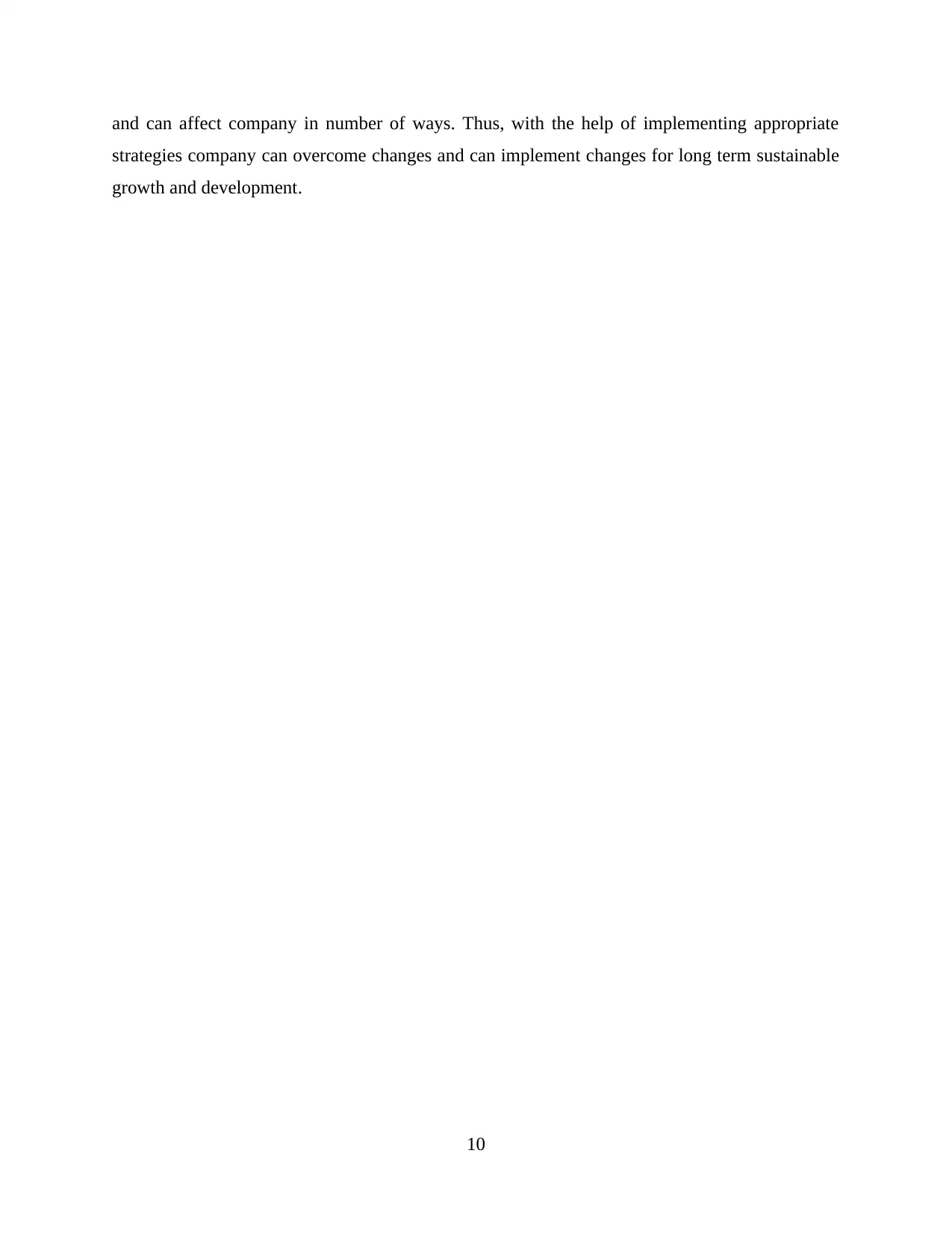
and can affect company in number of ways. Thus, with the help of implementing appropriate
strategies company can overcome changes and can implement changes for long term sustainable
growth and development.
10
strategies company can overcome changes and can implement changes for long term sustainable
growth and development.
10
Paraphrase This Document
Need a fresh take? Get an instant paraphrase of this document with our AI Paraphraser
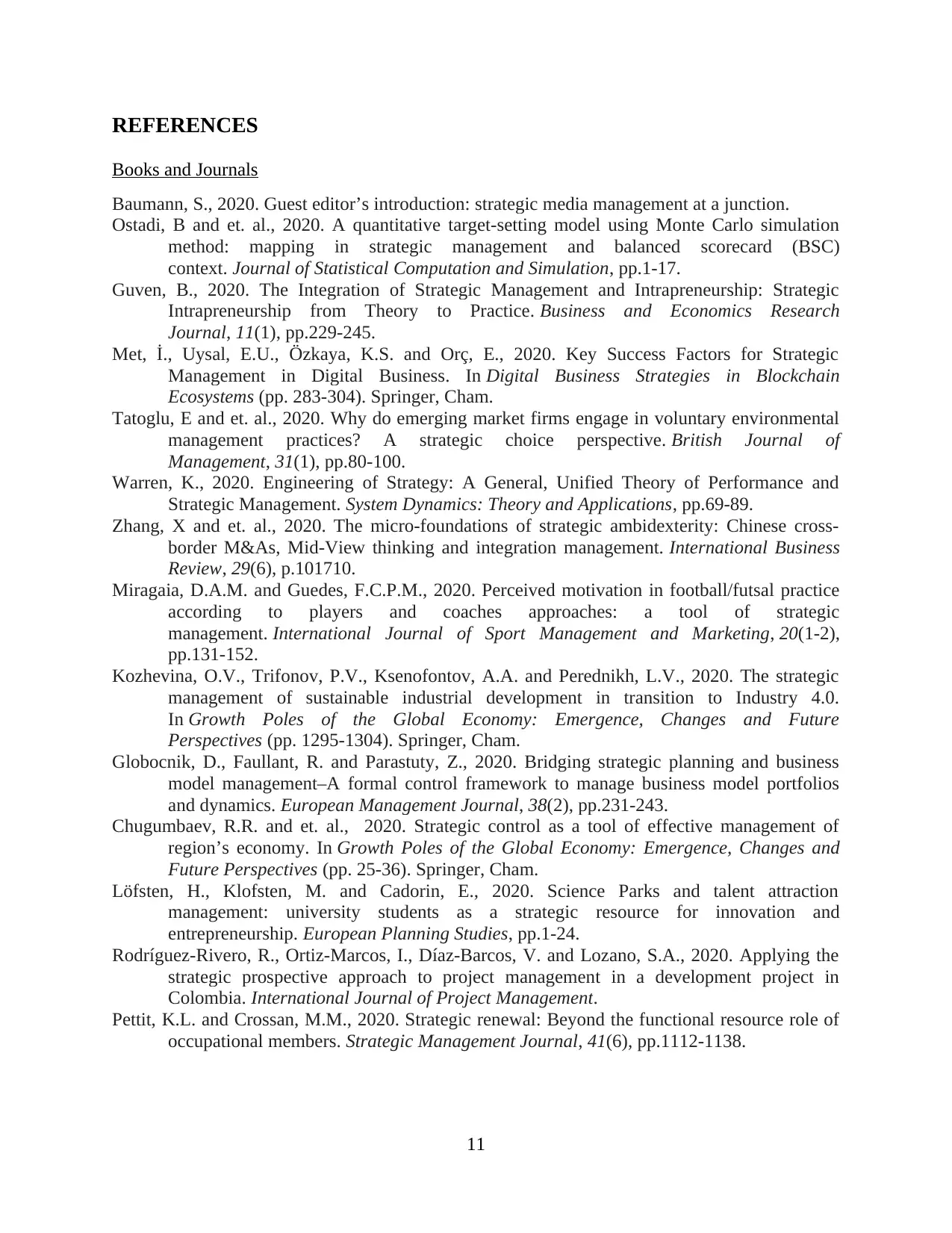
REFERENCES
Books and Journals
Baumann, S., 2020. Guest editor’s introduction: strategic media management at a junction.
Ostadi, B and et. al., 2020. A quantitative target-setting model using Monte Carlo simulation
method: mapping in strategic management and balanced scorecard (BSC)
context. Journal of Statistical Computation and Simulation, pp.1-17.
Guven, B., 2020. The Integration of Strategic Management and Intrapreneurship: Strategic
Intrapreneurship from Theory to Practice. Business and Economics Research
Journal, 11(1), pp.229-245.
Met, İ., Uysal, E.U., Özkaya, K.S. and Orç, E., 2020. Key Success Factors for Strategic
Management in Digital Business. In Digital Business Strategies in Blockchain
Ecosystems (pp. 283-304). Springer, Cham.
Tatoglu, E and et. al., 2020. Why do emerging market firms engage in voluntary environmental
management practices? A strategic choice perspective. British Journal of
Management, 31(1), pp.80-100.
Warren, K., 2020. Engineering of Strategy: A General, Unified Theory of Performance and
Strategic Management. System Dynamics: Theory and Applications, pp.69-89.
Zhang, X and et. al., 2020. The micro-foundations of strategic ambidexterity: Chinese cross-
border M&As, Mid-View thinking and integration management. International Business
Review, 29(6), p.101710.
Miragaia, D.A.M. and Guedes, F.C.P.M., 2020. Perceived motivation in football/futsal practice
according to players and coaches approaches: a tool of strategic
management. International Journal of Sport Management and Marketing, 20(1-2),
pp.131-152.
Kozhevina, O.V., Trifonov, P.V., Ksenofontov, A.A. and Perednikh, L.V., 2020. The strategic
management of sustainable industrial development in transition to Industry 4.0.
In Growth Poles of the Global Economy: Emergence, Changes and Future
Perspectives (pp. 1295-1304). Springer, Cham.
Globocnik, D., Faullant, R. and Parastuty, Z., 2020. Bridging strategic planning and business
model management–A formal control framework to manage business model portfolios
and dynamics. European Management Journal, 38(2), pp.231-243.
Chugumbaev, R.R. and et. al., 2020. Strategic control as a tool of effective management of
region’s economy. In Growth Poles of the Global Economy: Emergence, Changes and
Future Perspectives (pp. 25-36). Springer, Cham.
Löfsten, H., Klofsten, M. and Cadorin, E., 2020. Science Parks and talent attraction
management: university students as a strategic resource for innovation and
entrepreneurship. European Planning Studies, pp.1-24.
Rodríguez-Rivero, R., Ortiz-Marcos, I., Díaz-Barcos, V. and Lozano, S.A., 2020. Applying the
strategic prospective approach to project management in a development project in
Colombia. International Journal of Project Management.
Pettit, K.L. and Crossan, M.M., 2020. Strategic renewal: Beyond the functional resource role of
occupational members. Strategic Management Journal, 41(6), pp.1112-1138.
11
Books and Journals
Baumann, S., 2020. Guest editor’s introduction: strategic media management at a junction.
Ostadi, B and et. al., 2020. A quantitative target-setting model using Monte Carlo simulation
method: mapping in strategic management and balanced scorecard (BSC)
context. Journal of Statistical Computation and Simulation, pp.1-17.
Guven, B., 2020. The Integration of Strategic Management and Intrapreneurship: Strategic
Intrapreneurship from Theory to Practice. Business and Economics Research
Journal, 11(1), pp.229-245.
Met, İ., Uysal, E.U., Özkaya, K.S. and Orç, E., 2020. Key Success Factors for Strategic
Management in Digital Business. In Digital Business Strategies in Blockchain
Ecosystems (pp. 283-304). Springer, Cham.
Tatoglu, E and et. al., 2020. Why do emerging market firms engage in voluntary environmental
management practices? A strategic choice perspective. British Journal of
Management, 31(1), pp.80-100.
Warren, K., 2020. Engineering of Strategy: A General, Unified Theory of Performance and
Strategic Management. System Dynamics: Theory and Applications, pp.69-89.
Zhang, X and et. al., 2020. The micro-foundations of strategic ambidexterity: Chinese cross-
border M&As, Mid-View thinking and integration management. International Business
Review, 29(6), p.101710.
Miragaia, D.A.M. and Guedes, F.C.P.M., 2020. Perceived motivation in football/futsal practice
according to players and coaches approaches: a tool of strategic
management. International Journal of Sport Management and Marketing, 20(1-2),
pp.131-152.
Kozhevina, O.V., Trifonov, P.V., Ksenofontov, A.A. and Perednikh, L.V., 2020. The strategic
management of sustainable industrial development in transition to Industry 4.0.
In Growth Poles of the Global Economy: Emergence, Changes and Future
Perspectives (pp. 1295-1304). Springer, Cham.
Globocnik, D., Faullant, R. and Parastuty, Z., 2020. Bridging strategic planning and business
model management–A formal control framework to manage business model portfolios
and dynamics. European Management Journal, 38(2), pp.231-243.
Chugumbaev, R.R. and et. al., 2020. Strategic control as a tool of effective management of
region’s economy. In Growth Poles of the Global Economy: Emergence, Changes and
Future Perspectives (pp. 25-36). Springer, Cham.
Löfsten, H., Klofsten, M. and Cadorin, E., 2020. Science Parks and talent attraction
management: university students as a strategic resource for innovation and
entrepreneurship. European Planning Studies, pp.1-24.
Rodríguez-Rivero, R., Ortiz-Marcos, I., Díaz-Barcos, V. and Lozano, S.A., 2020. Applying the
strategic prospective approach to project management in a development project in
Colombia. International Journal of Project Management.
Pettit, K.L. and Crossan, M.M., 2020. Strategic renewal: Beyond the functional resource role of
occupational members. Strategic Management Journal, 41(6), pp.1112-1138.
11

12
⊘ This is a preview!⊘
Do you want full access?
Subscribe today to unlock all pages.

Trusted by 1+ million students worldwide
1 out of 12
Related Documents
Your All-in-One AI-Powered Toolkit for Academic Success.
+13062052269
info@desklib.com
Available 24*7 on WhatsApp / Email
![[object Object]](/_next/static/media/star-bottom.7253800d.svg)
Unlock your academic potential
Copyright © 2020–2025 A2Z Services. All Rights Reserved. Developed and managed by ZUCOL.




